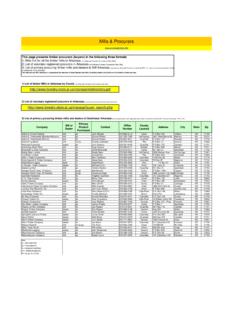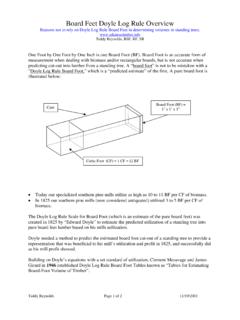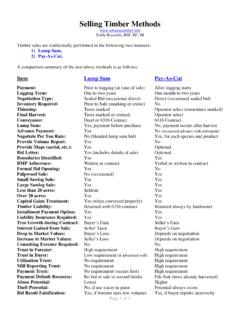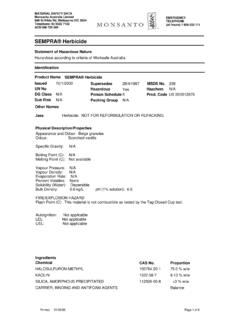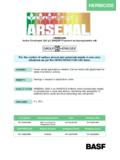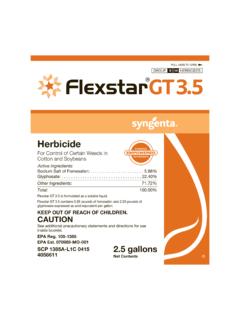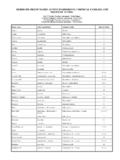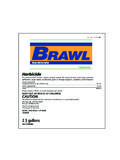Transcription of Herbicide Applications - Arkansas Timber.info: …
1 Herbicide Applications Royal Tyler, BSF, RF and James Pongetti - BASF Introduction If you d like to get the most out of your forestland and ensure future forest health, proper forest management is critical. Getting the most from your forestland can include objectives such as income, wildlife habitat, recreation or aesthetics. In most cases, it s all or a combination of these factors. The proper use of herbicides can be a very important part of a good forest management plan. Forestry herbicides can benefit any pine forest landowner, whether they re practicing natural stand management or plantation management. herbicides provide an effective, economical means of reducing competition from undesirable vegetation in a pine forest. Undesirable vegetation in your forest competes for limited resources such as water, nutrients, soil space and sunlight.
2 herbicides can help reduce the level of competition in your forestland, providing more resources for desired vegetation and valuable pine trees. Pine tree species usually respond well to additional resources, growing much bigger and faster than they would in areas with competition from undesirable brush and trees. This means you ll potentially get more volume of valuable wood, faster growth into higher value products and shorter rotation times all of which can mean you ll get more income from your land. Research shows that the use of herbicides in a forest management plan can dramatically increase a pine forest s volume growth. Historically, landowners might expect to grow a half to one cord per acre per year on their land. Today, with more intensive management tools such as herbicides , tillage, fertilizer and better seedlings expectations are 4 5 cords per acre per year.
3 Through effective competition control, growth increases can be obtained of one-half cord per acre per year or more, per Herbicide treatment. These increased volumes represent an estimated Real Rate of Return (RROR) of 8 - 15 percent annually, based on research and operational work over the years. Selective herbicides not only promote tree growth, they can also promote better wildlife habitat. Proper use of site-specific herbicides can increase the level of preferred wildlife foods such as forbs, grass and legume species. Reducing the level of undesirable brush species can also allow for more sunlight to reach the soil surface, which enables more desirable species to germinate and grow. More natural preferred food for wildlife can complement your food-plot work and enhance your property value for hunting leases.
4 herbicides can have other benefits as well, such as opening up your forest for better visibility and accessibility. Application of herbicides Forestry herbicides can be applied using several different methods, including helicopter, tractor and handheld or backpack sprayer. Cost of application typically ranges from $ $ per acre, depending on a number of factors: volume of water required for coverage of tract acres being treated location of tract access to tract with equipment Types of Applications Pine forestry management generally involves four types of Herbicide Applications : 1) Site Preparation 2) Herbaceous Weed Control 3) Early Release 4) Mid-Rotation Release 1) Site Preparation treatments occur after final harvest and prior to planting, usually during the months of June - October.
5 This treatment usually has the greatest impact on the growth of your pine stand. Site prep allows you to reduce the woody competition before you ever plant a tree, helping your crop trees get off to a fast, unimpeded start which can pay big dividends down the road. Good site preparation can greatly increase the chance of a pine s survival during its first critical years of its life. Site preparation also features a number of other benefits: Enables you to remove many unwanted species that you may not be able to address with herbicides after you plant your pine. Provides for better access to your land by your planting crew. Creates a brownout for a burn if you are burning your tract, which provides better access and can mean a better, more uniform planting job.
6 Leaves a minimum impact on the land as far as compaction or soil disturbance. Site prep herbicides can be used alone or in combination with mechanical site prep treatments or with tillage practices, depending on the needs of the site. Mechanical site prep can appear to do a good job of cleaning a site, but it doesn t address the woody roots below the ground, which means woody brush will return soon after mechanical treatments. This is where herbicides used in combination with mechanical site prep can provide an effective solution. Typical Herbicide site preparation treatments usually cost between $ $ , plus application costs, depending on the treatment that is required on your tract. The treatment required is based on type of species present, vegetation density and your plans on burning the tract.
7 Typical Site Preparation Treatments Site Prep Treatment Cost per acre* Use Considerations OneStep Herbicide @ 128 $ + application cost General site preparation treatment, controls many species and provides some brownup for burn. Accord SP @ 2 gal/acre + Chopper Herbicide @ 16 oz/ac $ +application cost Pine control treatment along with hardwood brush. Excellent brownup for burn Chopper Herbicide @ 48 oz. + Accord SP (Glyphosate) @ 1 qt. /acre $ + application cost General site preparation treatment, controls many species with good long-term control. Chopper Herbicide @ 64 ** $ + application cost Site preparation treatment with soil residual for herbaceous grass control next spring. Timing and tract condition dictate use.
8 Chopper Herbicide @ 40 oz/acre + Oust Extra @ 4 oz/acre** $ + application cost Site preparation treatment with residual for herbaceous weed control next spring . Timing and tract condition dictate use. *These costs are estimates only. ** This treatment would act as site prep and herbaceous weed control treatment in one single application, thus saving money vs separate site prep and herbaceous treatment. 2) Herbaceous Weed Control is used to control undesired annual and perennial grasses and weeds during a pine stand s first or second growing season. This is a critical time in which the pine establishes itself in the forest area. Root growth and diameter growth are both important to getting the pine off to a good start. These are much more important in establishment than height, which is commonly incorrectly used as the best indicator of successful first year establishment.
9 Herbaceous weed treatments provide tremendous growth responses the first year of treatment and stay with the tree through its rotation, resulting in accelerated pine development for shorter rotations and greater volumes. Herbaceous treatments also increase a pine s chances of survival in the first year of planting. Arkansas summers can be tough on freshly planted pines and competition control greatly increases your chances of successful stand establishment. Even when effective site prep treatments are used, herbaceous weed control is necessary for maximum yields. In studies, pine volume is maximized with both woody and herbaceous plants are controlled. Herbaceous treatments are usually applied after planting, usually in the March May timeframe. Treatments are usually broadcast (treating the entire tract) or banded (treating a specific area around the pine seedling).
10 While band Applications tend to cost less due to less Herbicide use per acre, broadcast treatments can generally increase pine growth over banded Applications , eliminate encroachment of vegetation from the untreated area and reduce reseeding of vegetation due to no untreated vegetation. All of these are factors to consider when deciding whether to apply herbicides through a band or broadcast method. Typical Herbaceous Weed Control Treatments Loblolly Pine Herbaceous Treatment Cost per acre* Use Considerations Arsenal Herbicide AC @ 4 6 oz. + Oust Extra Herbicide @ 1 2 oz. /acre $ $ + application cost Standard treatment for forestry sites, good on most sites Arsenal Herbicide AC @ 6 8 oz. + Oust XP or Oust Extra Herbicide @ 1 2 oz.
